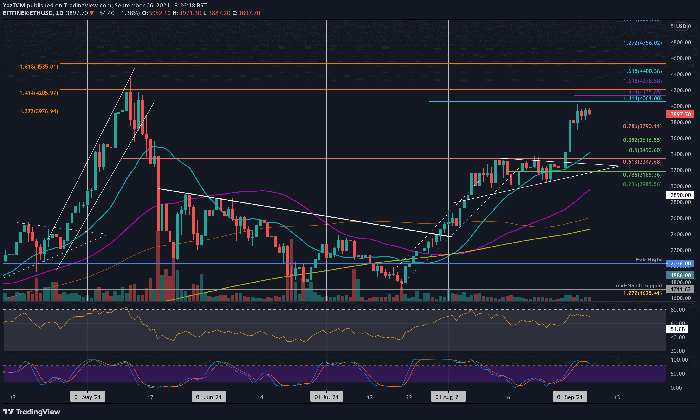The recent Ethereum sell-off has captured the attention of the crypto community as investors grapple with the implications for the future of this leading digital asset. With Ethereum’s price hovering around $1,600, the sell-off has been driven by a notable exit from various market participants, including both institutional players and retail investors. Recent market analysis indicates that this wave of disposals could add significant sell pressure on ETH, raising critical questions about the stability of its price support levels. Investors are keen to understand how this sell-off may affect Ethereum price predictions moving forward, especially in light of dwindling buyer confidence. As Ethereum struggles to maintain momentum, the fate of its market lies in the balance, prompting a closer look at trading patterns and investor sentiment in the coming days.
In the ever-evolving landscape of cryptocurrencies, the sharp decline in Ethereum’s value raises concerns about the overall health of the market. This downturn, often referred to as the Ethereum market shakeout, points to a broader trend affecting digital currency investment strategies. Investors, from institutional whalelike players to casual retail traders, are reevaluating their positions as liquidity drains from the asset. As sentiments shift amid a challenging environment for ETH, discussions surrounding future price trajectories and investment analyses become increasingly urgent. The need to comprehend the underlying factors contributing to this downturn becomes essential for prospects of recovery and growth in the crypto sphere.
Ethereum Sell-Off: A New Trend Among Investors
The ongoing sell-off of Ethereum (ETH) by a plethora of investors marks a significant shift in market sentiment. Institutions, whales, and even retail investors are liquidating their positions, creating an environment of heightened sell pressure. Recent data indicates that notable players, including Galaxy Digital, have contributed to this trend, with reports showing substantial amounts of ETH moving to centralized exchanges. This wave of selling is concerning as it suggests a lack of confidence in the asset, further exacerbating fears around ETH price predictions and market stability.
The ramifications of this increase in ETH sell-offs cannot be underestimated. With large whales dispossessing significant volumes, like the recorded 143,000 ETH from prominent holders, the market might experience troubling changes. Combined with the recent trends in retail selling, where small investors are cashing out, it raises questions about the future of Ethereum. Understanding the collective actions of these diverse investor groups gives insight into the prevailing crypto market analysis surrounding Ethereum and its current price trajectory.
Ethereum Price Support: Will It Hold?
As Ethereum prices currently hover around $1,600, a crucial juncture comes into focus: the critical support level at $1,528. This support has been built on the investments of over 4.8 million ETH from 2.61 million addresses, indicating substantial investor confidence at this price point. However, with increased sell-off activity, the resilience of this support is being tested like never before. If the price dips below this level, analysts warn that we may see a rapid decline to $1,100, which could trigger further panic and market instability.
The current market analysis of ETH highlights the importance of robust price support mechanisms, particularly in turbulent times. While some analysts maintain a bullish outlook on Ethereum, advocating for potential rebounds and breakout scenarios, the reality is that sustained selling pressure from both institutional and retail investors could dramatically limit its upwards potential. Should the ETH price fail to reclaim lost ground, many investors will be left questioning their strategies and the viability of Ethereum as a long-term investment.
Institutional Selling vs. Retail Investors: Who’s Losing Confidence?
The contrasting behavior of institutional versus retail investors paints a revealing picture of the current Ethereum market dynamics. Institutions like Galaxy Digital, which have been significant ETH holders, appear to be offloading their assets at an alarming rate, indicating a possible loss of long-term confidence in ETH. This substantial withdrawal of capital from professional and institutional investors creates a ripple effect, putting additional pressure on the price of Ethereum and fostering a bearish sentiment throughout the market.
On the flip side, retail investors are also participating in this sell-off, increasingly capitulating during this downturn. The scenario where a long-term holder sells their ETH at a substantial loss exemplifies the anxiety pervasive among everyday investors. This dual trend, where both institutional and retail sectors show signs of distress, complicates the landscape for Ethereum. Investors must now navigate these challenges, armed with insights from ETH market analysis and understanding how sell pressure shapes potential forecasts for Ethereum’s future.
The Future of Ethereum: Price Predictions and Market Trends
With the Ethereum market currently under strain, the outlook for the future requires a careful analysis of both historical performance and current trends. Many analysts are now focusing on ETH price predictions in light of recent market movements and investor behavior. While some remain optimistic, expecting a potential surge towards the $3,000 mark, the prevailing sentiment is largely cautious. Market trends suggest volatility is on the rise, prompting questions about sustainable growth in the near term.
Furthermore, as Ethereum seeks to navigate through its many challenges—including decreased institutional support and sustained sell pressure—the focus will also turn to the broader economic influences such as regulatory changes and market confidence. Investors are advised to keep abreast of developments within the Ethereum ecosystem, for these factors will play a crucial role in shaping ETH’s trajectory moving forward. As the situation evolves, continuous market analysis and adaptive strategies will be essential for Ethereum investors.
Whales and Their Impact on Ethereum’s Market Stability
Whales, or large investors holding significant amounts of Ethereum, play a central role in maintaining market stability—or introducing volatility. Their recent sell-offs have alarmed many in the crypto community, as massive liquidations can destabilize prices and instigate further downturns. When whales choose to offload their ETH, it often sends ripple effects throughout the market, leading to increased sell pressure as smaller investors react to the movements of these larger players.
The ongoing actions of these whales become a critical area of focus for those analyzing ETH’s price predictions. Their ability to influence price movements cannot be overstated, and when they exit positions en masse, it raises valid concerns regarding the resilience of Ethereum’s market support. Investors must consider these dynamics when assessing their portfolios, as the decisions of these influential entities directly correlate with market health and long-term investment strategies.
Retail Investor Behavior: The Ripple Effect on ETH Prices
Retail investors are often seen as the backbone of the cryptocurrency market, and their behavior can significantly influence overall price action. Currently, a concerning trend of retail sell-offs in Ethereum is emerging, where individual investors are liquidating significant amounts of their holdings amidst fears of further price declines. This collective action is not only impacting ETH prices but also creating broader market uncertainty as the sentiment shifts toward pessimism.
The phenomenon of retail capitulation is crucial to monitor, as panic selling can create a domino effect, prompting even more investors to cash out. This sell pressure is compounded by the actions of larger market players, such as institutional investors and whales, thereby shaping the future landscape of ETH. Understanding retail investor behavior can empower smaller holders as they navigate potential volatility and strategize their next moves in the ever-changing crypto landscape.
Market Analysis: Ethereum vs. Other Cryptocurrencies
In conducting a comprehensive market analysis, it becomes essential to compare Ethereum’s performance against other cryptocurrencies. As the second-largest cryptocurrency by market capitalization, Ethereum’s health often reflects broader market conditions. Observations of Ethereum’s sell-offs in conjunction with those across other top assets provide a clearer picture of the overall crypto market sentiment. Notably, many investors may choose to shift their focus from Ethereum to other promising altcoins during periods of downturn, potentially exacerbating ETH’s sell pressure.
Moreover, this comparative analysis offers insights into where Ethereum stands in the larger investment ecosystem. While Ethereum has historically been a pioneer in smart contracts and decentralized applications, its current struggles may make it less attractive to new investors compared to emerging projects that offer innovative solutions. As ETH price stability is under scrutiny, market watchers will need to keep a close eye on the competitive landscape and how Ethereum adapts to evolving trends.
The Role of News and Sentiment in Ethereum’s Price Fluctuations
News and market sentiment wield substantial influence over cryptocurrency prices, and Ethereum is no exception. Factors such as regulatory announcements, technological developments, and larger economic indicators can rapidly shift investor sentiment, prompting significant price fluctuations. When sentiment turns negative, as seen with the recent sell-offs, it can instigate panic among investors, leading to increased liquidity and further driving prices down.
Moreover, the way news is disseminated and interpreted can lead to a cascading effect in the market. For instance, negative media coverage regarding Ethereum’s scalability issues or market manipulation allegations can overwhelm the optimism surrounding potential ETH upgrades. Investors must remain aware of how external factors can independently or cumulatively affect Ethereum’s price support and market viability, shaping their investment strategies accordingly.
The Long-Term Outlook for Ethereum Amidst Current Challenges
Despite the current turbulence within the Ethereum market, many analysts are still eyeing a long-term bullish outlook as the second-largest cryptocurrency navigates through its challenges. Ethereum’s capability for adaptation, reflected in its ongoing updates and community innovation, suggests that it could eventually emerge stronger from this phase. However, investors must remain vigilant, as the persistence of sell-off trends can test the very foundation of Ethereum’s long-term potential.
Successful navigation of current issues will hinge upon Ethereum’s ability to bolster user confidence and attract new investment. The ongoing developments, such as Ethereum 2.0 implementations and evolving use cases, are key to securing ETH’s position in the competitive cryptocurrency landscape. As market conditions fluctuate, understanding the trajectory of these elements becomes vital for any investor looking to stake a claim in Ethereum’s promising future.
Frequently Asked Questions
What is causing the current Ethereum sell-off among investors?
The current Ethereum sell-off is largely driven by significant offloading by institutions, whales, and retail investors alike. Notably, Galaxy Digital has offloaded substantial amounts of ETH, depositing $80 million to centralized exchanges. Additionally, whale participants have sold off 143,000 ETH recently, contributing to increased sell pressure in the market.
How does the Ethereum sell-off impact ETH price predictions?
The ongoing Ethereum sell-off is detrimental to price predictions for ETH, particularly as it recently dipped to around $1,400, close to its two-year low. Current price support is identified at $1,528, and should this level fail, it may lead to a further decline towards $1,100, affecting broader price forecasts.
What trends are emerging from the Ethereum market analysis during this sell-off?
Recent Ethereum market analysis reveals a prominent trend of capitulation among investors, with both large institutions and smaller holders participating in the sell-off. For example, significant losses have been reported by wallets that held ETH for extended periods before liquidating at a loss, indicating increasing sell pressure in the market.
What strategies can Ethereum investors employ amid the current sell-off?
In light of the Ethereum sell-off, investors may need to adopt cautious strategies, including monitoring key support levels such as the $1,528 mark, which is vital for preventing a deeper price decline. Additionally, investors should remain informed about market dynamics and consider diversifying their portfolios to mitigate potential risks associated with ETH.
How can the Ethereum sell-off impact the overall crypto market?
The Ethereum sell-off can have rippling effects on the overall crypto market, especially as ETH is the second-largest cryptocurrency by market cap. A significant decline in ETH prices can instigate panic selling among other cryptocurrencies, leading to a broader crypto market downturn and heightened sell pressure across the board.
What should I watch for in the ETH price support during this sell-off?
While monitoring the ETH price support during this sell-off, key levels to watch include the $1,528 support zone. If ETH fails to maintain this level, it may trigger further declines toward $1,100. Investors should keep a close eye on trading volumes and market sentiments to gauge potential price movements.
Are there any positive indications for Ethereum despite the sell-off?
Despite the Ethereum sell-off, some analysts remain bullish, noting that ETH may attempt to break out from a descending channel, possibly leading to price recoveries. If buying volumes increase and support withstands selling pressure, there is a potential for ETH to rally back toward previous highs, such as $3,000.
| Key Points |
|---|
| A growing number of investors are liquidating their ETH holdings, signaling potential future troubles for Ethereum. |
| Galaxy Digital has reportedly deposited $80 million worth of ETH into exchanges like Binance and Coinbase, indicating even major players are offloading. |
| Ethereum whales sold 143,000 ETH worth around $230 million in just one week, intensifying market pressures. |
| Only one minor inflow was recorded in April, while investors pulled out nearly $1 billion over 34 out of 40 days, leading to significant losses. |
| Smaller investors are also selling their ETH at a loss, with one wallet offloading $2.6 million worth after an 11-month hold. |
| Ether recently hit a two-year low of $1,400, with potential support at $1,528; failing this could lead to a drop to $1,100. |
| Despite the bearish trend, some analysts remain hopeful, suggesting potential for a bounce back to as high as $3,000. |
Summary
The Ethereum sell-off has created a tense environment in the cryptocurrency market, as many investors, including institutions and retail participants, continue to offload their holdings. With Ethereum currently struggling at $1,600, questions arise about its future trajectory. Analysts suggest key support levels are critical for ETH to avoid further declines, and while sentiment is largely bearish, there remains a faction of optimism among traders aiming for a potential recovery.
The recent Ethereum sell-off has sent shockwaves through the crypto market, leaving investors grappling with uncertainty about the future of ETH. As key players like Galaxy Digital and prominent whales unload significant amounts of their holdings, concerns about the cryptocurrency’s price stability intensify. With the Ethereum price hovering around $1,600, many are questioning whether this is a temporary dip or the start of a more substantial downturn. Analysts are closely watching the charts for signs of support; indications suggest that a failure to hold the $1,528 level could see Ethereum plummeting further down to $1,100. Amidst the growing crypto sell pressure, Ethereum investors need to stay informed with the latest ETH market analysis to make educated decisions in these turbulent times.
In the wake of substantial divestments in the crypto sector, the recent trend surrounding Ethereum has raised eyebrows across the digital currency landscape. As institutional giants and market whales continue to liquidate their positions, many are left pondering the sustainability of Ethereum’s value. The prevailing question looms large: What will this mean for the next wave of investors in Ethereum? With widespread market fluctuations and a notable lack of support at critical price levels, Ethereum’s resilience is being tested more than ever. Crypto enthusiasts and stakeholders must look to comprehensive Ethereum price predictions to navigate these challenging waters.















Leave a Reply